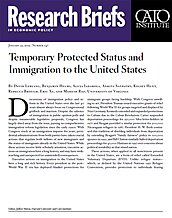Discussions of immigration policy and reform in the United States over the last 40 years almost always focus on Congressional gridlock and inaction. Despite the salience of immigration in public opinion polls and despite innumerable legislative proposals, Congress has largely shied away from the issue, passing no comprehensive immigration reform legislation since the early 1990s. With Congress stuck at an immigration impasse for years, presidential administrations from both parties have taken crucial actions that regulate both inflows of new immigrants and the status of immigrants already in the United States. While these actions receive little scholarly attention, executive actions on immigration have a long history, and may have widereaching and unexpected (or unintended) consequences.
Executive actions on immigration to the United States have a long and rich history. Every president in the post– World War II era has deployed blanket protections for immigrant groups facing hardship. With Congress unwilling to act, President Truman issued executive grants of relief following World War II for groups targeted and displaced by Nazi Germany. Kennedy extended and expanded protections to Cubans due to the Cuban Revolution. Carter suspended deportation proceedings for 250,000 Silva letter-holders in 1977 and Reagan provided a similar protection for 200,000 Nicaraguan refugees in 1987. President H. W. Bush continued this tradition of shielding individuals from deportation by extending Reagan’s “family fairness” policy to 100,000 spouses in 1990, and Bill Clinton similarly halted deportation proceedings for 40,000 Haitians in 1997 over concerns about political instability in that island nation.
These actions, when applied to all noncitizens present in the United States, are a form of relief called Extended Voluntary Departure (EVD). Unlike refugee status— which, as defined by the United Nations 1951 Refugee Convention, provides protection to individuals fearing persecution—EVD provides blanket coverage to all noncitizens present in the United States in the event that their country experiences a natural disaster, civil conflict, or other humanitarian crisis. The application of EVD is optional: in practice, the Secretary of State makes a case to the Attorney General that the conditions in a particular country would place returning foreign nationals at risk. The Attorney General, in turn, issues what amounts to a form of prosecutorial discretion that directs immigration authorities to not pursue deportation proceedings against individuals from the country in question. Between 1960 and 1990, EVD was granted to foreign nationals from 16 countries. President George H. W. Bush used his executive authority to provide a similar kind of relief—known as Deferred Enforced Departure (DED)—to Chinese nationals after the Tiananmen Square Massacre in 1989.
Over the course of the 1980s, members of Congress and the public at large grew concerned about what they viewed as the arbitrary—and increasingly political—use of EVD and DED. Most noticeably, concerns over the Reagan administration’s refusal to grant El Salvadorians either refugee status or EVD led to congressional action, which culminated in the Immigration Act of 1990. Established by Congress, the Immigration Act of 1990 grants Temporary Protective Status (TPS) to foreign nationals from nations experiencing excessively difficult living conditions but who do not qualify as refugees. These conditions may be borne from natural disaster, political and economic instability, or violent conflict. Managed by the Secretary of Homeland Security but in close consultation with the president, TPS offers two critical benefits to foreign nationals: a temporary shielding from deportation proceedings (even if the migrant arrived in the United States illegally) and legal access to the formal labor market. TPS is initially granted for two years and can be renewed indefinitely, but TPS can also be terminated at the discretion of the executive branch. Executive actions by President Trump and current Secretary of Homeland Security Kirstjen Nielsen made this clear when they ended TPS protections for more than 400,000 immigrants from El Salvador, Honduras, Haiti, Nicaragua, Sudan, and Nepal.
What are the consequences of TPS for immigration to the United States? Surprisingly, there is no scholarship on this question. In our research, we exploit the fact that migrants who hold TPS receive access to the formal US labor market regardless of their legal status. Labor market access allows migrants to obtain employment opportunities that, on average, pay higher wages than if they did not have formal labor market access. In line with models from the new economics of labor migration that conceive of migration as a household risk diversification strategy, we expect TPS holders who have obtained higher-paying jobs to remit more money home to their friends and family than they would without TPS. These remittances increase household incomes in crisis-affected countries, reducing the propensity for other household members to migrate for economic opportunity. And we show, both theoretically and empirically, that this increase in remittances decreases the demand for migration—both legal and illegal—into the United States.
NOTE:
This research brief is based on David Leblang, Benjamin Helms, Alexa Iadarola, Ankita Satpathy, Kelsey Hunt, Rebecca Brough, Eric Xu, and Mahesh Rao, “Temporary Protected Status and Immigration to the United States,” June 2018, https://papers.ssrn.com/sol3/papers.cfm?abstract_id=3206009.
About the Authors

This work is licensed under a Creative Commons Attribution-NonCommercial-ShareAlike 4.0 International License.
